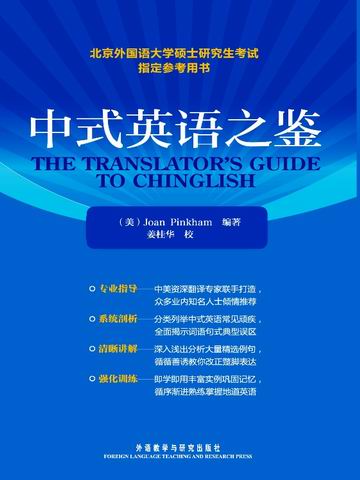你的英语还是具有汉语特色的英语吗?阅读此书,让你的英语更地道。
This book can be used either in the classroom or for independent study. It is addressed primarily to Chinese translators and to advanced students of English who are practicing translation. Naturally, readers who open this book will have reached varying levels of skill in their second language. But to one degree or another, the work of all but the most highly trained and experienced among them will inevitably contain elements of Chinglish. Chinglish, of course, is that misshapen, hybrid language that is neither English nor Chinese but that might be described as "English with Chinese characteristics." The purpose of the book is rather to show translators—and, by extension, others who are writing directly in English—how to recognize elements of Chinglish in a first draft and how to revise it so as to eliminate those elements. In other words, this book is intended to help them turn their work into real English such as might have been written by an educated native speaker of the language.
《中式英语之鉴》十分系统地探讨了中式英语这一非常普遍的现象。作者琼·平卡姆是美国人,毕生从事翻译工作。她曾先后在外文出版社和中央编译工作过8年,专门给中国翻译工作者翻译的英译文作修改和润色。8年中她积累了大量的典型中式英语实例,她根据这些例子把中式英语的具体表现科学地加以分门别类。
该书可用于课堂教学,也可用于自学。其主要对象是中国的翻译工作者以及做翻译练习的高年级英语学生。当读者翻阅这本书时,他们使用第二语言的技能所达到的水平是不同的。但是,除了那些造诣很深的,一般人的翻译中都会不同程度地含有中式英语的成分。当然,所谓中式英语就是那种畸形的、混合的、既非英语又非汉语的语言文字,也可称其为“具有汉语特色的英语”。这本书的目的则在于帮助翻译工作者以及其他直接用英语写作的人懂得如何在初稿中找出中式英语的成分并将其修改掉。也就是说,这本书是为了帮助他们将自己的写作修改成为地道的英语,就像一个受过教育的以英语为母语的人写的一样。
- To the Reader
- Part One: Unnecessary Words
- Part One: I. Unnecessary Nouns and Verbs
- Part One: II. Unnecessary Modifiers
- Part One: III. Redundant Twins
- Part One: IV. Saying the Same Thing Twice
- Part One: V. Repeated References to the Same Thing
- Part One: VI. Summing it All Up
- Part Two: Sentence Structure
- Part Two: VII. The Noun Plague
- Part Two: VIII. Pronouns and Antecedents
- Part Two: IX. The Placement of Phrases and Clauses
- Part Two: X. Dangling Modifiers
- Part Two: XI. Parallel Structure
- Part Two: XII. Logical Connectives
- Part Two: XIII. Summing it All Up
- Part Three: Supplementary Examples
- Key to Exercises
- Selected Bibliography
- Copyright Page



















 京公网安备 11010802032529号
京公网安备 11010802032529号
笔记加载中...